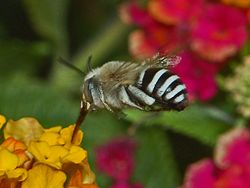
Bees are winged insects closely related to wasps and ants, known for their roles in pollination and, in the case of the best-known bee species, the western honey bee, for producing honey. Bees are a monophyletic lineage within the superfamily Apoidea. They are presently considered a clade, called Anthophila. There are over 16,000 known species of bees in seven recognized biological families. Some species – including honey bees, bumblebees, and stingless bees – live socially in colonies while most species (>90%) – including mason bees, carpenter bees, leafcutter bees, and sweat bees – are solitary.

Eristalis tenax, the common drone fly, is a common, migratory, cosmopolitan species of hover fly. It is the most widely distributed syrphid species in the world, and is known from all regions except the Antarctic. It has been introduced into North America and is widely established. It can be found in gardens and fields in Europe and Australia. It has also been found in the Himalayas.

Bombus ternarius, commonly known as the orange-belted bumblebee or tricolored bumblebee, is a yellow, orange and black bumblebee. It is a ground-nesting social insect whose colony cycle lasts only one season, common throughout the northeastern United States and much of Canada. The orange-belted bumblebee forages on Rubus, goldenrods, Vaccinium, and milkweeds found throughout the colony's range. Like many other members of the genus, Bombus ternarius exhibits complex social structure with a reproductive queen caste and a multitude of sister workers with labor such as foraging, nursing, and nest maintenance divided among the subordinates.

Bombus sylvestris, known as the forest cuckoo bumblebee or four-coloured cuckoo bee, is a species of cuckoo bumblebee, found in most of Europe and Russia. Its main hosts are Bombus pratorum, Bombus jonellus, and Bombus monticola. As a cuckoo bumblebee, Bombus sylvestris lays its eggs in another bumblebee's nest. This type of bee leaves their young to the workers of another nest for rearing, allowing cuckoo bumblebees to invest minimal energy and resources in their young while still keeping the survival of their young intact.

Conops quadrifasciatus, the yellow-banded conops, is a species of fly from the genus Conops in the family Conopidae.
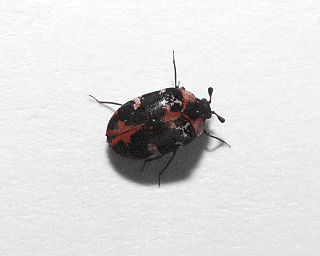
Anthrenus (Anthrenus) scrophulariae, also known as the common carpet beetle or buffalo carpet beetle, is a species of beetle originally found in Europe, the Middle East and the Nearctic, which has now spread to most of the world. Adult beetles feed on pollen and nectar, but the larvae feed on animal fibres and can be damaging pests to carpets, fabrics and museum specimens.

Andrena marginata, sometimes called the small scabious mining bee is a species of the sand bee (Andrena) genus.

Bombus occidentalis, the western bumblebee, is one of around 30 bumblebee species present in the western United States and western Canada. A recent review of all of its close relatives worldwide appears to have confirmed its status as a separate species.

The hairy-footed flower bee is a species of bee belonging to the family Apidae.

Colletes hederae, the ivy bee, is a species of plasterer bee belonging to the family Colletidae subfamily Colletinae.

Gasteruption jaculator is a species of the family Gasteruptiidae, subfamily Gasteruptiinae.
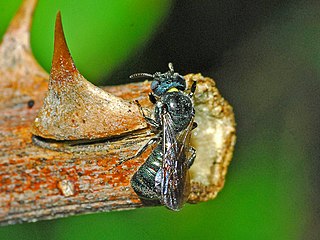
Ceratina cyanea, common name blue carpenter bee, is a species of bee belonging to the family Apidae, subfamily Xylocopinae.
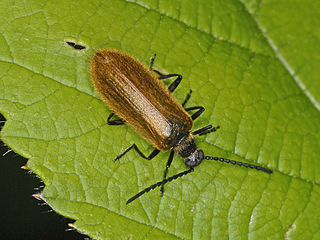
Lagria hirta is a species of beetles in the family Tenebrionidae.

Anthophora dispar is a species of bee belonging to the family Apidae subfamily Apinae tribus Anthophorini.

Sphecodopsis is a genus of cleptoparasitic "cuckoo" bees in the family Apidae. Endemic to southern Africa, the wasp-like bees of this genus are generally small, varying from 3.9 to 9 mm in length, and mostly black, with orange-ish or reddish colouring of the metasoma in some of the species. The bee genus Scrapter is recognised as a host for the cleptoparasitic life cycle of some Sphecodopsis, but further data regarding preferred hosts is not available for most of the species.
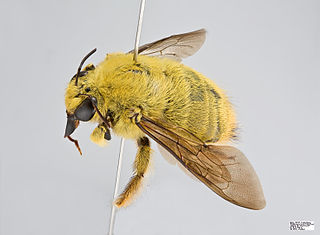
Xylocopa caffra is a species of Afrotropical carpenter bee that ranges from west to central and southern Africa, besides Madagascar and some Indian Ocean archipelagos.
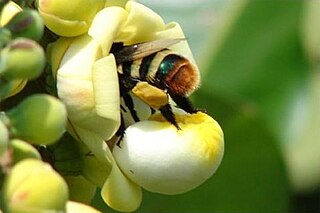
Eulaema meriana is a large-bodied bee species in the tribe Euglossini, otherwise known as the orchid bees. The species is a solitary bee and is native to tropical Central and South America. The male collects fragrances from orchid flowers, which it stores in hollows in its hind legs. Orchids can be deceptive by mimicking the form of a female and her sex pheromone, thus luring male bees or wasps. Pollination will take place as the males attempt to mate with the labellum, or the tip petal of the flower. Male E. meriana are territorial and have a particular perch on a tree trunk where it displays to attract a female. After mating, the female builds a nest with urn-shaped cells made with mud, feces, and plant resin, and provisions these with nectar and pollen before laying an egg in each. These bees also have complex foraging and wing buzzing behaviors and are part of a mimicry complex.

Coelioxys, common name leaf-cutting cuckoo bees or sharp-tailed bees , is a genus of solitary kleptoparasitic or brood parasitic bees, belonging to the family Megachilidae.

Eufriesea surinamensis belongs to the tribe of euglossine bees and as such is a species of orchid bee. This should not be mistaken with the species group surinamensis, which includes Ef. surinamensis among other Eufriesea species.

Bombus morio is one of the few bumblebee species found in South America. These bees reside mainly in the forests of Brazil, nesting on the surface of the ground. They are one of the biggest species of bumblebee and are important pollinators. They are one of the few species of bees that exhibit buzz pollination to collect pollen from the flowers.

